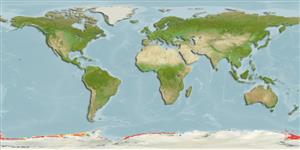>
Perciformes/Notothenioidei (Icefishes) >
Artedidraconidae (Barbled plunderfishes)
Etymology: Artedidraco: Petrus (Peter) Artedi, (10 Mar.) 1705-35 (28 Sep.), a son of a clergyman from Anundsjö named Olaus Arctaedius, in the northern part of Sweden.In 1729 he changed his name from Arctaedius to Arctædi, a name still later simplified to Artedi (Ref. 45335).
More on author: Regan.
Environment: milieu / climate zone / depth range / distribution range
Ecologia
marino demersale; distribuzione batimetrica 82 - 801 m. Polar; 66°S - 77°S
Southern Ocean: East Antarctica (Ross Sea, South Victoria Land, Weddell Sea).
Size / Peso / Age
Maturity: Lm ? range ? - ? cm
Max length : 15.2 cm TL maschio/sesso non determinato; (Ref. 124149); 16.7 cm TL (female); peso massimo pubblicato: 38.00 g (Ref. 124149); peso massimo pubblicato: 38.00 g
Found on the sublittoral and continental shelf. Feeds mainly on gammaridean amphipods, with substantial amounts of errant polychaetes. Isopods were a minor food item.
Life cycle and mating behavior
Maturities | Riproduzione | Spawnings | Egg(s) | Fecundities | Larve
Eakin, R.R., 1990. Artedidraconidae. p. 332-356. In O. Gon and P.C. Heemstra (eds.) Fishes of the Southern Ocean. J.L.B. Smith Institute of Ichthyology, Grahamstown, South Africa. (Ref. 5181)
IUCN Red List Status (Ref. 130435)
Threat to humans
Harmless
Human uses
Pesca: di nessun interesse
Strumenti
Special reports
Download XML
Fonti Internet
Estimates based on models
Preferred temperature (Ref.
123201): -1.8 - 0.3, mean -1 °C (based on 290 cells).
Phylogenetic diversity index (Ref.
82804): PD
50 = 0.5156 [Uniqueness, from 0.5 = low to 2.0 = high].
Bayesian length-weight: a=0.00537 (0.00340 - 0.00847), b=3.27 (3.13 - 3.41), in cm total length, based on LWR estimates for this species & (Sub)family-body (Ref.
93245).
Trophic level (Ref.
69278): 3.2 ±0.45 se; based on food items.
Resilienza (Ref.
120179): Medio, tempo minimo di raddoppiamento della popolazione 1.4 - 4.4 anni (Assuming fec > 100).
Fishing Vulnerability (Ref.
59153): Low vulnerability (10 of 100).
